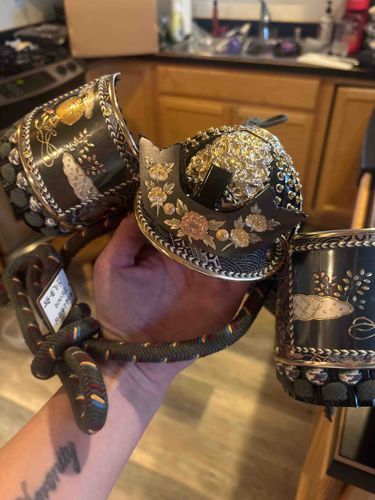
Japanese Lacquered and Gilt Metal Armor Component
The item appears to be a highly ornate Japanese kabuto (helmet) or possibly a decorative component from a larger samurai armor set, specifically a sode (shoulder guard) or part of a mempo (face mask), given its curved form and size relative to the hand holding it. It is predominantly dark, likely black lacquer or dark metal, adorned with extensive gold and silver embellishments. The primary decorative motifs include chrysanthemums and other floral designs, as well as abstract patterns and what appear to be natural elements like grasses or reeds. The floral motifs, particularly the chrysanthemums, are rendered in various shades of gold and possibly copper or rose gold, suggesting a sophisticated use of different metallic inlays or pigments. The details are crisp, indicating fine craftsmanship. There are borders with a repeating geometric pattern, possibly a seigaiha (waves) or a similar traditional Japanese design, rendered in metallic gold or silver, providing a striking contrast to the dark ground. The item exhibits a high level of detail, with some areas appearing textured, such as the matted gold finish on certain parts of the central dome-like element, which mimics a hammered or granulated surface. The visible condition is good; while there might be minor signs of age-appropriate wear, no significant damage, fading, or missing pieces are immediately apparent. The surfaces retain their luster. A dark cord or rope, possibly silk and cotton blend, with colorful interwoven threads (red, blue, yellow) is attached, suggesting functionality for securing the piece or as part of its display. This cord also appears to have a small tag with Japanese characters and numbers, which could be an inventory tag, a museum tag, or a seller's mark, potentially offering clues about its provenance. The overall aesthetic points to a Meiji period (1868-1912) or possibly late Edo period (1603-1868) origin, given the intricate and elaborate decorative style often associated with that era's metalwork and lacquerware.
AI-Generated Appraisal Disclaimer
Estimated Value
$3,000-5,000
Basic Information
Category
Decorative Arts/Collectibles
Appraised On
November 27, 2025
Estimated Value
$3,000-5,000
Item Description
The item appears to be a highly ornate Japanese kabuto (helmet) or possibly a decorative component from a larger samurai armor set, specifically a sode (shoulder guard) or part of a mempo (face mask), given its curved form and size relative to the hand holding it. It is predominantly dark, likely black lacquer or dark metal, adorned with extensive gold and silver embellishments. The primary decorative motifs include chrysanthemums and other floral designs, as well as abstract patterns and what appear to be natural elements like grasses or reeds. The floral motifs, particularly the chrysanthemums, are rendered in various shades of gold and possibly copper or rose gold, suggesting a sophisticated use of different metallic inlays or pigments. The details are crisp, indicating fine craftsmanship. There are borders with a repeating geometric pattern, possibly a seigaiha (waves) or a similar traditional Japanese design, rendered in metallic gold or silver, providing a striking contrast to the dark ground. The item exhibits a high level of detail, with some areas appearing textured, such as the matted gold finish on certain parts of the central dome-like element, which mimics a hammered or granulated surface. The visible condition is good; while there might be minor signs of age-appropriate wear, no significant damage, fading, or missing pieces are immediately apparent. The surfaces retain their luster. A dark cord or rope, possibly silk and cotton blend, with colorful interwoven threads (red, blue, yellow) is attached, suggesting functionality for securing the piece or as part of its display. This cord also appears to have a small tag with Japanese characters and numbers, which could be an inventory tag, a museum tag, or a seller's mark, potentially offering clues about its provenance. The overall aesthetic points to a Meiji period (1868-1912) or possibly late Edo period (1603-1868) origin, given the intricate and elaborate decorative style often associated with that era's metalwork and lacquerware.
Related Tags
Get Your Items Appraised
Instant estimates of your treasures with AI-powered instant appraisals